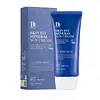What's inside
What's inside
 Key Ingredients
Key Ingredients

 Benefits
Benefits

 Concerns
Concerns

 Ingredients Side-by-side
Ingredients Side-by-side

Water
Skin ConditioningZinc Oxide
Cosmetic ColorantCyclohexasiloxane
EmollientButyloctyl Salicylate
Skin ConditioningPropanediol
SolventPropylheptyl Caprylate
EmollientIsododecane
EmollientPolyglyceryl-3 Polydimethylsiloxyethyl Dimethicone
Skin ConditioningDicaprylyl Carbonate
EmollientCaprylyl Methicone
Skin ConditioningNiacinamide
SmoothingDisteardimonium Hectorite
StabilisingHamamelis Virginiana Extract
AntiseborrhoeicMagnesium Sulfate
Methyl Methacrylate Crosspolymer
Vinyl Dimethicone/Methicone Silsesquioxane Crosspolymer
Triethoxycaprylylsilane
1,2-Hexanediol
Skin ConditioningPolyglyceryl-2 Dipolyhydroxystearate
Skin ConditioningLauryl Polyglyceryl-3 Polydimethylsiloxyethyl Dimethicone
Skin ConditioningGlyceryl Caprylate
EmollientCalamine
AbsorbentDipotassium Glycyrrhizate
HumectantMadecassoside
AntioxidantInositol
HumectantPanthenol
Skin ConditioningMadecassic Acid
Skin ConditioningAsiaticoside
AntioxidantAsiatic Acid
Skin ConditioningCaprylyl Glycol
EmollientEthylhexylglycerin
Skin ConditioningAdenosine
Skin ConditioningRosmarinus Officinalis Leaf Oil
MaskingTocopherol
AntioxidantButylene Glycol
HumectantWater, Zinc Oxide, Cyclohexasiloxane, Butyloctyl Salicylate, Propanediol, Propylheptyl Caprylate, Isododecane, Polyglyceryl-3 Polydimethylsiloxyethyl Dimethicone, Dicaprylyl Carbonate, Caprylyl Methicone, Niacinamide, Disteardimonium Hectorite, Hamamelis Virginiana Extract, Magnesium Sulfate, Methyl Methacrylate Crosspolymer, Vinyl Dimethicone/Methicone Silsesquioxane Crosspolymer, Triethoxycaprylylsilane, 1,2-Hexanediol, Polyglyceryl-2 Dipolyhydroxystearate, Lauryl Polyglyceryl-3 Polydimethylsiloxyethyl Dimethicone, Glyceryl Caprylate, Calamine, Dipotassium Glycyrrhizate, Madecassoside, Inositol, Panthenol, Madecassic Acid, Asiaticoside, Asiatic Acid, Caprylyl Glycol, Ethylhexylglycerin, Adenosine, Rosmarinus Officinalis Leaf Oil, Tocopherol, Butylene Glycol
Water
Skin ConditioningPropanediol
SolventCI 77891
Cosmetic ColorantPhenyl Trimethicone
Skin ConditioningDicaprylyl Carbonate
EmollientMethylpropanediol
SolventCyclopentasiloxane
Emollient1,2-Hexanediol
Skin ConditioningGlycereth-26
HumectantMethyl Trimethicone
Skin ConditioningPolyglyceryl-2 Caprate
EmulsifyingMethyl Methacrylate Crosspolymer
Styrene/Ma Copolymer
Emulsion StabilisingSucrose Stearate
EmollientTromethamine
BufferingSimmondsia Chinensis Seed Oil
EmollientAcrylates/C10-30 Alkyl Acrylate Crosspolymer
Emulsion StabilisingCellulose Gum
Emulsion StabilisingHydroxypropyl Methylcellulose
Emulsion StabilisingCetyl Hydroxyethylcellulose
Emulsion StabilisingStearic Acid
CleansingAlumina
AbrasiveBetaine
HumectantTrehalose
HumectantGlyceryl Caprylate
EmollientButylene Glycol
HumectantPentylene Glycol
Skin ConditioningEthylhexylglycerin
Skin ConditioningSqualane
EmollientCentella Asiatica Extract
CleansingAloe Barbadensis Leaf Extract
EmollientMadecassoside
AntioxidantButylene Glycol Dicaprylate/Dicaprate
EmollientCarbomer
Emulsion StabilisingPolyacrylate Crosspolymer-6
Emulsion StabilisingT-Butyl Alcohol
PerfumingParfum
MaskingWater, Propanediol, CI 77891, Phenyl Trimethicone, Dicaprylyl Carbonate, Methylpropanediol, Cyclopentasiloxane, 1,2-Hexanediol, Glycereth-26, Methyl Trimethicone, Polyglyceryl-2 Caprate, Methyl Methacrylate Crosspolymer, Styrene/Ma Copolymer, Sucrose Stearate, Tromethamine, Simmondsia Chinensis Seed Oil, Acrylates/C10-30 Alkyl Acrylate Crosspolymer, Cellulose Gum, Hydroxypropyl Methylcellulose, Cetyl Hydroxyethylcellulose, Stearic Acid, Alumina, Betaine, Trehalose, Glyceryl Caprylate, Butylene Glycol, Pentylene Glycol, Ethylhexylglycerin, Squalane, Centella Asiatica Extract, Aloe Barbadensis Leaf Extract, Madecassoside, Butylene Glycol Dicaprylate/Dicaprate, Carbomer, Polyacrylate Crosspolymer-6, T-Butyl Alcohol, Parfum
 Reviews
Reviews

Ingredients Explained
These ingredients are found in both products.
Ingredients higher up in an ingredient list are typically present in a larger amount.
1,2-Hexanediol is a synthetic liquid and another multi-functional powerhouse.
It is a:
- Humectant, drawing moisture into the skin
- Emollient, helping to soften skin
- Solvent, dispersing and stabilizing formulas
- Preservative booster, enhancing the antimicrobial activity of other preservatives
Butylene Glycol (or BG) is used within cosmetic products for a few different reasons:
Overall, Butylene Glycol is a safe and well-rounded ingredient that works well with other ingredients.
Though this ingredient works well with most skin types, some people with sensitive skin may experience a reaction such as allergic rashes, closed comedones, or itchiness.
Learn more about Butylene GlycolDicaprylyl Carbonate comes from carbonic acid and caprylyl alcohol, a fatty alcohol. It is an emollient and gives skin a velvet feel. The sources of Dicaprylyl Carbonate may be synthetic or from animals.
As an emollient, Dicaprylyl Carbonate creates a film on the skin. This film traps moisture in, keeping your skin soft and hydrated.
Ethylhexylglycerin (we can't pronounce this either) is commonly used as a preservative and skin softener. It is derived from glyceryl.
You might see Ethylhexylglycerin often paired with other preservatives such as phenoxyethanol. Ethylhexylglycerin has been found to increase the effectiveness of these other preservatives.
Glyceryl Caprylate comes from glycerin and caprylic acid, a fatty acid from coconut. It has emollient and emulsifier properties.
As an emollient, it helps hydrate your skin. Emollients work by creating a barrier on your skin to trap moisture in, helping to keep your skin soft and smooth.
On the other hand, emulsifiers prevent ingredients (such as oil and water) from separating.
Learn more about Glyceryl CaprylateMadecassoside comes from the super popular skin-soothing ingredient, Centella asiatica. It is one of four active compounds found in the extract of Centella Asiatica.
Madecassoside has antioxidant, anti-inflammatory, and hydrating properties. It contains fatty acids, amino acids, beta-carotene, and phytochemicals.
One study found using Madecassoside with ascorbic acid helped reduce the signs of aging and improved skin hydration.
Learn more about MadecassosideThis ingredient comes as a powder made up of small, porous, microbeads. It is used to add a silky feel to products and also helps absorb oil.
Propanediol is an all-star ingredient. It softens, hydrates, and smooths the skin.
It’s often used to:
Propanediol is not likely to cause sensitivity and considered safe to use. It is derived from corn or petroleum with a clear color and no scent.
Learn more about PropanediolWater. It's the most common cosmetic ingredient of all. You'll usually see it at the top of ingredient lists, meaning that it makes up the largest part of the product.
So why is it so popular? Water most often acts as a solvent - this means that it helps dissolve other ingredients into the formulation.
You'll also recognize water as that liquid we all need to stay alive. If you see this, drink a glass of water. Stay hydrated!
Learn more about Water